Aventurine
A translucent quartz or quartzite with sparkling reflections. It occurs in a range of colors.
Author: Hobart M. King, PhD, GIA Graduate Gemologist

Translucent Aventurine: A small polished piece of aventurine about three centimeters across that shows the translucence, highly included nature and aventurescence of the material. The green inclusions in the stone are fuchsite, a green, chromium-rich mica similar to muscovite.
What is Aventurine?
Aventurine is a variety of translucent quartz or quartzite with abundant small plate- or flake-shaped inclusions. Light entering the quartz strikes these inclusions and reflects from them. This produces a sparkly appearance known as "aventurescence." The inclusions can also impart a distinct, and often beautiful, color to the material.
When the inclusions are abundant and in a common orientation, their reflections can be eye-catching. This property, along with desirable colors, are what give aventurine its appeal as a gemstone. Aventurine is most often green, but also occurs in orange, yellow, red, pink, brown, white, gray, and blue.
Spelling Note: Aventurine is spelled with a "v" as the second letter, but many people think the second letter is a "d". Speak distinctly and write carefully to help them learn.
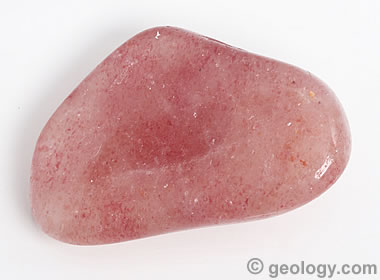
Pink Aventurine: This photograph shows a tumbled stone of pink aventurine. The pink color and aventurescence is produced by tiny flakes of lepidolite mica within the quartz. Click here for a close-up view that shows how few flakes of lepidolite are needed to impart color in aventurine. Using a gemological microscope and focusing on individual flakes below the surface of the stone often reveals their pseudohexagonal habit.
Table of Contents
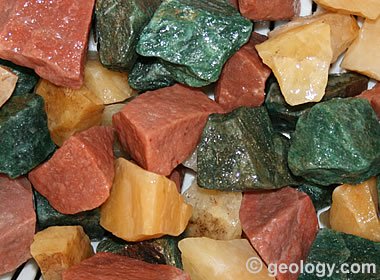
Colorful Aventurine: Pieces of green, yellow, and reddish-orange aventurine tumbling rough from India. These pieces of rough average about 3 centimeters across.
Types of Inclusions
The most common inclusion in aventurine is fuchsite, a green chromium-rich mica. Just a few percent fuchsite by volume can impart a distinct green color to aventurine.
Some specimens of aventurine contain ten to twenty percent fuchsite. Such a large amount can cause problems. If the fuchsite flakes are in a common orientation, they can impart a "cleavage" to the material. If the grains are coarse, they can form pits at each location where they intersect the polished surface.
Small reflective particles of other materials can cause aventurescence in quartz and quartzite. Flakes of lepidolite mica can impart a pink, red or purple color. Hematite and goethite can produce pink, orange, red, and brown aventurine. Muscovite and ilmenite can produce gray, yellowish or silvery aventurine. The bright reflections and attractive colors make aventurine a popular semiprecious gemstone.
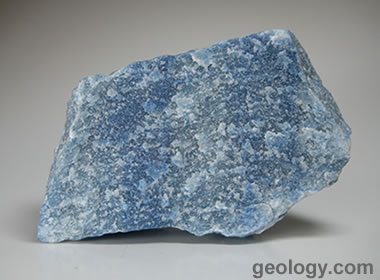
Blue Aventurine: A blue specimen of aventurescent quartz from India. This specimen is about ten centimeters across.
Sources of Aventurine
Small amounts of aventurine have been found in many parts of the world. India is by far the most important commercial producer of aventurine. Brazil is the second-place producer. Russia, Spain, Austria, and Tanzania produce smaller amounts of aventurine.
Some people hold the opinion that most of the material sold today as "aventurine" has inadequate aventurescence to merit the name. Immediately discernible aventurescence in quartz is hard to find, and remarkable aventurescence is rare.
Physical Properties of Aventurine |
|
| Chemical Classification | Silicate - SiO2 |
| Color | Usually green. Also orange, yellow, red, pink, purple, white, brown, and blue. |
| Streak | Colorless (harder than the streak plate). |
| Luster | Vitreous, aventurescent. |
| Diaphaneity | Translucent to nearly opaque. |
| Cleavage | None, conchoidal fracture. Abundant mica inclusions with a common orientation can cause a preferential direction of easy breakage. |
| Mohs Hardness | 6.5 to 7 (A lower apparent hardness is observed if mica inclusions are abundant.) |
| Specific Gravity | 2.6 to 2.7 (can be higher if heavily included) |
| Diagnostic Properties | Aventurescence, often green, hardness, conchoidal fracture. Microscopic examination with darkfield illumination will show tiny color-causing inclusions. |
| Chemical Composition | SiO2 |
| Crystal System | Trigonal. |
| Uses | Gemstones, small sculptures, utility items, ornamental stone. |
Physical Properties of Aventurine
Aventurine has most of the properties of quartz, its dominant ingredient. The presence of inclusions gives the quartz its aventurescence and alters some of its other properties.
Aventurine can have an apparent hardness of less than 7. The most common mineral inclusions associated with aventurine all have a hardness lower than the 7 of quartz. Abundant inclusions weaken the material and result in a lower apparent hardness.
Many of the common aventurine inclusions have a specific gravity that is higher than quartz. If abundant, inclusions such as hematite, ilmenite, and goethite can give aventurine a specific gravity that is higher than quartz.
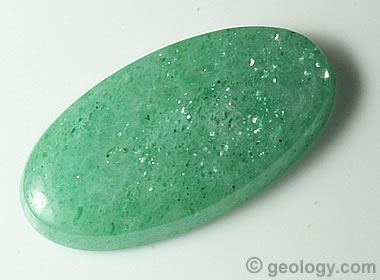
Aventurine Cabochon: A brightly polished cabochon cut from a piece of light green aventurine.
Uses of Aventurine
Green aventurine is a common material used to produce beads and cabochons. These are used to make earrings, pendants, rings, and other jewelry. Other colors of aventurine are used to produce these items, but they are seen less often because nice aventurine in those colors is less common.
Aventurine is sometimes used to make bowls, vases, and small sculptures. Green aventurine is a popular and less expensive alternative for jade and amazonite. Some buyers simply want an attractive green stone, and the flash of aventurine suits them.
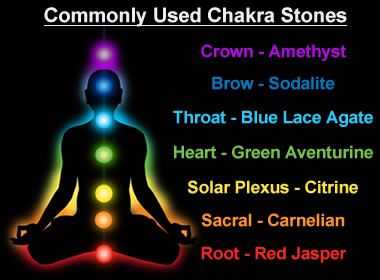
Chakra stones: Chakras are "spiritual centers" of the body. Commonly used chakra stones include: amethyst (crown chakra), sodalite (brow chakra), blue lace agate (throat chakra), green aventurine (heart chakra), citrine (solar plexus chakra), carnelian (sacral chakra), and red jasper (root chakra). Image copyright iStockphoto / Artecke.
Aventurine as a "Healing Crystal"
Many people use tumbled stones in crystal healing, color therapy, or other types of alternative medicine. The stones are placed on the body where discomfort occurs or on "spiritual centers" known as "chakras." Green aventurine is often used to represent the fourth, or heart, chakra.
These practices have a long history of use, and some people report benefits. But, they have not been scientifically proven to cure any condition that they are used to treat. Medical experts consider their benefits to be a result of the placebo effect.
The treatments themselves are usually not harmful. However, some people delay seeking genuine medical care while a dangerous condition is progressing.
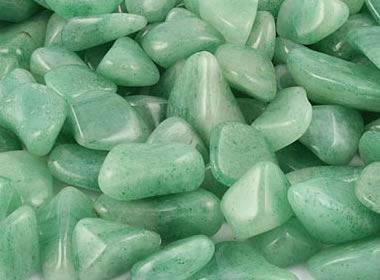
Tumbled Aventurine: Light green aventurine that has been tumble-polished into attractive polished stones. Image provided by RockTumbler.com.
Aventurine as Tumbled Stones
Aventurine is an inexpensive and popular material for making tumbled stones in a rock tumbler. If the mica particles are small, a smooth and lustrous finish can be produced. Coarse mica particles tend to pluck out, giving the polished stones a pitted appearance. Aluminum oxide, cerium oxide, and tin oxide will all produce a bright polish on aventurine.
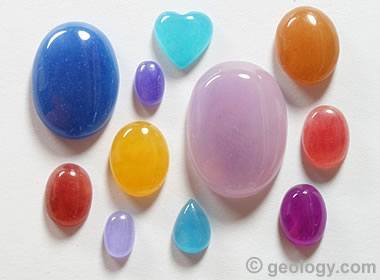
Dyed "Aventurine": Aventurine with very faint aventurescence and common quartz are often dyed to produce brightly colored cabochons and other items. The dyed cabochons in the photo above were sold as "aventurine" by several different vendors. Shoppers should be aware that not all stones sold as "aventurine" are worthy of the name. Be cautious, especially when you see outrageous colors.
Aventurine Treatments and Fakes
Aventurine and translucent quartz without aventurescence are often dyed bright colors. Dye is used to produce low-cost cabochons with bright colors that are often seen in inexpensive jewelry. The name "aventurine" can be inappropriate, but it is used for its greater appeal in the marketplace when compared to "translucent quartz" or other appropriate names.

Oregon Sunstone: Some feldspars are aventurescent. "Oregon Sunstone" is an example that is cut as both a faceted stone and a cabochon. The stone on the left is a 7 mm round aventurescent cabochon with abundant copper platelets weighing 2.29 carats. The unincluded stone on the left is a beautiful orange 7x5 mm oval faceted stone weighing 1.01 carats. Both varieties are known as "sunstone." These stones were cut from rough mined at the Spectrum Sunstone Mine near Plush, Oregon.
More About Aventurescence
The phenomenon of aventurescence is the glittering appearance produced by light entering a stone and reflecting from small reflective grains of metal or mineral. This phenomenon is not confined to quartz.
Oligoclase and plagioclase feldspars sometimes contain inclusions of hematite or copper that produce an aventurescent luster. These are known as "aventurescent feldspars" or by the more popular name "sunstone."
A few lava flows in Oregon contain vugs that host small feldspar crystals. These crystals sometimes contain suspended flakes of copper or other minerals and display aventurescence under direct light. These feldspars, aventurescent or not, are all called "Oregon Sunstone." The gem material ranges in color from very pale yellow to orange to red. Some blue, green, and color-zoned crystals are also found. Aventurescent pieces are cut into cabochons, and some of the finest aventurescent pieces are cut into faceted stones. Pieces with perfect clarity are faceted. Oregon Sunstone is very popular with people who live in these areas and tourists who visit.
Aventurescent iolite is also known. Transparent blue iolite with inclusions of hematite platelets, mica, and other materials are known from locations in India and Tanzania. These are often sold under the misnomer "iolite sunstone."

Aventurescent Glass: Goldstone is a man-made aventurine simulant produced by mixing fine metal particles into a transparent glass. It has a much stronger aventurescence than most specimens of natural aventurine. The glass used for the base can be clear, green, blue, purple, or other colors.
"Goldstone" and "Aventurescent Glass"
The name "aventurine" originated in the 1600s when Italian glass makers accidentally blended tiny particles of copper into a batch of molten glass. The result was a sparkly glass that they named "avventura" or, in English, "by chance." It was beautiful. Soon they were using this new glass to make a variety of products, and the name "aventurine" began to spread.
Similar glasses are still made today. They are known as "aventurine glass." The most popular of these glasses is a simulant of aventurine known as "goldstone." Goldstone is easy to recognize because the metal particles within the glass are such strong reflectors of light. The typical product is a clear glass with copper flakes, but sometimes blue or green "goldstone" is made by using colored glass instead of clear. Goldstone is a popular material for producing cabochons and other jewelry items.
| More Gemstones |
 |
Birthstones |
 |
Diamond |
 |
Blue Gemstones |
 |
100+ Gems |
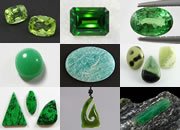 |
Green Gemstones |
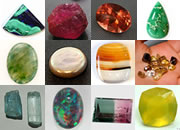 |
Mined in America |
 |
Ruby and Sapphire |
 |
Tumbled Stones |

Find Other Topics on Geology.com:

|

| ||

|

| ||

|

| ||

|

|

